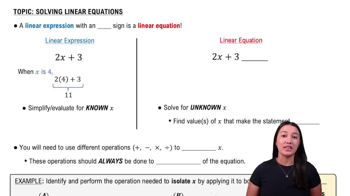Table of contents
- 0. Review of College Algebra4h 43m
- 1. Measuring Angles39m
- 2. Trigonometric Functions on Right Triangles2h 5m
- 3. Unit Circle1h 19m
- 4. Graphing Trigonometric Functions1h 19m
- 5. Inverse Trigonometric Functions and Basic Trigonometric Equations1h 41m
- 6. Trigonometric Identities and More Equations2h 34m
- 7. Non-Right Triangles1h 38m
- 8. Vectors2h 25m
- 9. Polar Equations2h 5m
- 10. Parametric Equations1h 6m
- 11. Graphing Complex Numbers1h 7m
0. Review of College Algebra
Solving Linear Equations
Problem 31b
Textbook Question
Find each sum or difference. See Example 1. |-8 - 6|
 Verified step by step guidance
Verified step by step guidance1
Identify the expression inside the absolute value: \(-8 - 6\).
Calculate the expression inside the absolute value: \(-8 - 6 = -14\).
Apply the absolute value operation: \(|-14|\).
Recall that the absolute value of a number is its distance from zero on the number line, which is always positive.
Thus, the absolute value of \(-14\) is \(14\).
Recommended similar problem, with video answer:
 Verified Solution
Verified SolutionThis video solution was recommended by our tutors as helpful for the problem above
Video duration:
1mPlay a video:
Was this helpful?
Key Concepts
Here are the essential concepts you must grasp in order to answer the question correctly.
Absolute Value
The absolute value of a number is its distance from zero on the number line, regardless of direction. It is denoted by vertical bars, such as |x|, and is always non-negative. For example, |−8| equals 8, and |−6| equals 6, as both values are 8 and 6 units away from zero, respectively.
Recommended video:

Sine, Cosine, & Tangent of 30°, 45°, & 60°
Operations with Absolute Values
When performing operations involving absolute values, it is essential to first evaluate the absolute values of the individual numbers before applying any arithmetic operations. For instance, in the expression |−8 - 6|, you would first calculate the result of −8 - 6, which equals −14, and then find the absolute value, resulting in |−14| = 14.
Recommended video:

Algebraic Operations on Vectors
Order of Operations
The order of operations is a set of rules that dictates the sequence in which mathematical operations should be performed to ensure consistent results. The common acronym PEMDAS (Parentheses, Exponents, Multiplication and Division, Addition and Subtraction) helps remember this order. In the context of absolute values, it is crucial to follow these rules to correctly evaluate expressions involving multiple operations.
Recommended video:

Algebraic Operations on Vectors

 7:48m
7:48mWatch next
Master Solving Linear Equations with a bite sized video explanation from Callie Rethman
Start learning



